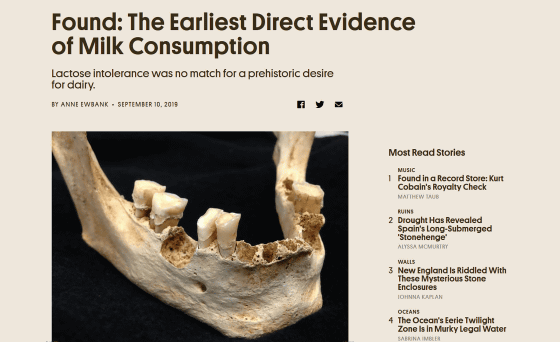Evidence that humans have loved milk since the era of `` being hungry when drinking milk '' can be found

by
Some people say that milk is their favorite food and drinks milk every morning, while many people say 'If you drink milk, you will get hungry.' In fact, it has been found that it is relatively recent that humans have been able to drink animal milk, but when investigating human bones discovered from a Neolithic site , People who had no time were also consuming food derived from milk . '
New insights into Neolithic milk consumption through proteomic analysis of dental calculus | SpringerLink
https://link.springer.com/article/10.1007/s12520-019-00911-7
Researchers find earliest evidence of milk consumption-News and events, The University of York
https://www.york.ac.uk/news-and-events/news/2019/research/earliest-evidence-milk-consumption/
Found: The Earliest Direct Evidence of Milk Consumption-Gastro Obscura
https://www.atlasobscura.com/articles/when-did-humans-start-drinking-milk

The phenomenon of `` being hungry when you drink milk '' occurs because the ability to break down
Most mammals grow up with their parents' milk, but as they grow they lose the activity of lactase , a digestive enzyme that breaks down lactose, making them unable to drink their milk. On the other hand, the lactase activity persists even in adults in some people, so it is possible to drink animal milk, which is termed lactase activity persistence . Recent genetic analysis shows that persistent lactase activity in Europe appeared 4000 years ago, and before that, people were hungry when they drank animal milk.
However, traces of dairy products have been detected from stone tools used more than 4000 years ago, and evidence that animal dairy farming has been carried out since earlier times has been found, and humans have become animals' milk. The discovery that it was 4000 years ago was resistant to many findings. Therefore, a research team led by Sophie Charlton , an archaeologist at the University of York, UK, analyzed the human bones that lived in the Neolithic era about 6000 years ago, and almost all people were lactose intolerant To find out if the animal's milk was being drunk.

by
The Neolithic period in Britain is seen around 4000-2400 BC. During this period, the cultivation of crops such as wheat and barley began, and livestock such as cattle, sheep, goats and pigs began to be used for agriculture. Archaeologists have discovered huge monuments and burial sites from the ruins at the time, and it is thought that the Neolithic people had complex cultural customs.
The research team investigated 10 remains found in three sites: Humbledon Hill in southern England, Haleston North , and Banbury Lane in East Midlands (East Midland) . To know the eating habits of the remains, the research team focused on mineralized plaque adhering to the teeth of the remains. During the formation of plaque, the protein of the food that the person was eating is trapped inside, so analyzing the plaque reveals the eating habits at that time.
As a result of the analysis, β-lactoglobulin , a type of whey protein found in milk and sheep milk, was discovered in 7 out of 10 plaques . This protein is not contained in human breast milk, so people at that time were eating animal milk.
It is also suggested that the remains of Humbledon Hill were drinking goat's milk, while the people of Haaleston North seemed to be drinking cow and sheep's milk. It seems that it was over the kind of.

by
In response to this result, Charlton said, “The fact that traces of β-lactoglobulin were also found in the remains found in three different Neolithic sites, the consumption of dairy products has spread since then. 'I suggest that.' Genetic studies have shown that people at the time were likely to have been intolerant to lactose, and the remains were either drinking very small amounts of milk or serving foods such as cheese from which lactose was removed. It may have been processed and ingested animal milk.
The results of this study show that people have had a culture of eating animal milk for a long time, and it may be the key to unravel the mechanism of the genetic mutation that caused lactase activity persistence. Charlton also said that investigating more remains and classifying the gender, age, social stratification, etc. of individuals who have traced animal milk could have interesting results.

by Pixabay
Related Posts:







